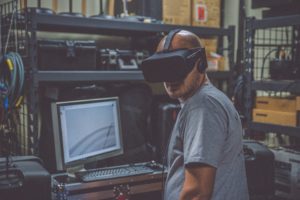The Department of Defense, along with industry, is arguing for an increase in military spending for fiscal year 2019, citing terrorism as a major concern. For this reason, the Aerospace Industries Association (AIA) has been very vocal about the need for increased spending on technology and innovation. We surmise that the DoD will make it a priority to invest in the following technologies for FY 2019.
FY 2019 Spending on End Point Devices and Security
We have come to expect the same level of technology at work that we have access to at home, and those who work in Government and the military are no different. This introduces a lot of opportunity for non-industry companies who aren’t doing business with the DoD today, specifically within Virtual Reality (VR). VR simulations have been used for years by the Government in flight, combat and medical trainings. Customs and Border Patrol also use VR simulations for police actions. The level of commercial innovation in VR is attracting Government interest. We expect to see the Government looking for more cutting-edge, commercial off-the-shelf (COTS) solutions, specifically within the VR industry. 
If the IoT (Internet of Things), such as mobile devices, tablets and laptops are being used for defense, it’s imperative that the DoD secure these endpoint devices from cyber attack. At the DISA (Defense Information Systems Agency) forecast to industry, it announced that the DoD will be funding creative ways to secure traditional and non-traditional endpoint devices from data breaches.
DoD Investment into Multi-Domain Operations and Security
American corporations underwent a shift in the last decade from siloed information sources to a time-sensitive robust single platform, cloud-hosted ERPs (Enterprise Resource Planning systems.) These now-commonplace systems manage multiple locations, massive amounts of data and are protected by data encryption and firewalls. The Government, formally limited by the inadequate data security within these platforms, is now open to cloud computing in light of new advances.
Multidomain operations (MDO) gives Government workers the ability to access information at any level for which they’re cleared and have permissions, anywhere in the world. It opens up the world for true joint operations between the different services, even between NATO allies. MDO allows them unbarred access, enabling cross-system and cross-functional data to become information, while maintaining the required segregation of security levels.
Cloud computing will soon become a reality for the Government as the private sector participates in building out hyper-secure systems. The Government’s first foray into multi-domain operations hasn’t turned out as expected. The combat cloud JEDI project is teaching the Government a valuable lesson—tech companies don’t always play well together, either in a philosophical or a technical sense. Different sources introduce vulnerabilities and open a system up to attack. The Government will continue to pursue the right solution for cloud computing in 2019.
Edge Computing for the Military and Government
Anytime you have to send data back and forth into the cloud, often from isolated areas, you get latency issues. Lag times, dropped signals and network outages aren’t acceptable when an immediate answer is mission critical. One of the ways around latency is edge computing. This doesn’t replace cloud storage but works within it. Edge computing is the idea that you keep the data source you need close on hand, in a local, rather than a cloud-based server. The local server can either be a traditional hardware server, or even the endpoint device or devices themselves. If the DoD can get a high speed, low latency transport to relay signals, it can control time-sensitive data transmissions through edge computing. Tech companies specializing in edge computing can expect to attract the DoD’s interest in the coming year.
Air Force Spending on IT Infrastructure
The Air Force is expected to spend significant money on infrastructure improvements for the F35 fighter. The contract with Lockheed-Martin came with delivery but not with sustainment. The Air Force will start contracting the sustainment of that program, including building facilities with modern technology that can support the technology and systems around the F35. They also need brand new buildings that have the ability to process, brief and discuss classified levels of information. None of the current infrastructure supports that right now. This opens up the door for a lot of small local businesses to get involved with IT cabling and other infrastructure applications for technology.
DoD Tech and Innovation Contract Trends for 2019
While OTAs will continue to grow steadily, the DoD appears to be moving towards broader, more interoperable contract vehicles targeted to specific tech. These contract vehicles are open to all of the services to use. One example is the GSA’s proposed new ATLAS vehicle, which will be designed to cater to the unmanned vehicle world. This has drawn a lot of attention from the business world. Navy contractors, for example, that normally wouldn’t do business with the Air Force may be open to pursuing an entirely new customer under these types of contracts. Another example is the NETCENTS-2 follow on, also coming out on GSA. The NETCENTS-2 was formerly an Air Force IDIQ contract but is going to be interoperable next year. It will continue to be IT focused, based on the GSA Schedule 70 requirements.
The Government will specifically earmark funding for small, innovative, fast technologies. In 2019, the DoD will be looking for niche capabilities and creative answers to hard-to-solve problems. While we don’t have a crystal ball that tells us what percentage of the budget the Government will spend on technology, we can see where they are headed based on the indicators mentioned above. Fiscal year 2019 will prove to be a good one for tech companies, especially those with a hand in virtual reality, data security, cloud computing or cabling and hardware.

